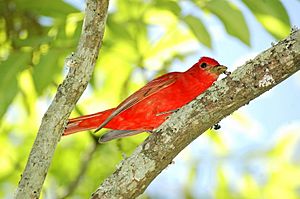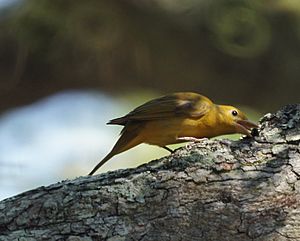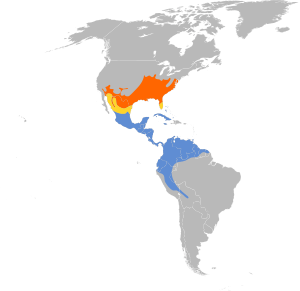Summer tanager facts for kids
Quick facts for kids Summer tanager |
|
|---|---|
 |
|
| Adult male in Hephzibah, Georgia | |
 |
|
| Adult female | |
| Conservation status | |
| Scientific classification | |
| Genus: |
Piranga
|
| Species: |
rubra
|
 |
|
| Range Summer breeding range Winter non-breeding range Migration | |
| Synonyms | |
|
|
The summer tanager (Piranga rubra) is a beautiful, medium-sized songbird found in the Americas. It is known for its bright colors. This bird used to be grouped with other tanagers. But now, scientists say it belongs to the cardinal family. This means it is related to birds like the Northern Cardinal. Summer tanagers look and sound a lot like other birds in the cardinal family.
Contents
Understanding the Summer Tanager's Name
The summer tanager was first officially described by a Swedish scientist. His name was Carl Linnaeus. He wrote about it in 1758 in his book Systema Naturae. He gave it the scientific name Fringilla rubra.
Linnaeus learned about this bird from Mark Catesby. Catesby had described and drawn the "summer red-bird" earlier. The name Piranga comes from a native South American language. It means a small bird. The word rubra is Latin for "red." This name perfectly describes the male bird's color!
What Does a Summer Tanager Look Like?
Adult summer tanagers have strong, pointed beaks. They are about 17 centimeters (6.7 inches) long. They usually weigh around 29 grams (1 ounce). Their wings can spread out to 28 to 30 centimeters (11 to 12 inches) wide.
Male summer tanagers are a bright rose-red color. They look similar to the hepatic tanager. But the hepatic tanager has a dark beak. Female summer tanagers are different. They are orangish on their bellies and olive on their backs. Their wings and tail are olive-brown.
Did you know that all their red and orange colors come from their food? They eat certain things that help them get these bright colors.
Summer Tanager Songs and Calls
The summer tanager has a song that sounds a bit like the American robin. Sometimes, people new to bird watching might even confuse them. Their song has many melodic parts. They repeat these parts in a steady stream.
However, the summer tanager's song is simpler than the robin's. It often uses only three or four different sounds. Their song is also clearer and not as nasal as the scarlet tanager's song. Summer tanagers also make a sharp, excited call. It sounds like pi-tuk or pik-i-tuk-i-tuk.
Where Do Summer Tanagers Live?
Summer tanagers like to live in open wooded areas. They especially like places with oak trees. You can find them breeding across the southern United States. Their breeding range goes as far north as Iowa.
When winter comes, these birds migrate south. They fly to Mexico, Central America, and northern South America. Sometimes, very rarely, a summer tanager might fly off course. It might end up in western Europe. This is called being a vagrant.
Summer Tanager Behavior and Diet
These birds often stay hidden high up in the trees. They look for food there. Sometimes, they fly out to catch insects in the air. Their main diet is insects. They especially love to eat bees and wasps. They also enjoy eating berries.
In their winter homes, they really like the fruit of a tree called Cymbopetalum mayanum. They will even look for food in places where humans live. If you plant these trees, you might attract them to your yard! They might also visit bird feeders.
Summer tanagers build their nests on horizontal tree branches. Their nests are shaped like a cup.
See also
 In Spanish: Tángara roja migratoria para niños
In Spanish: Tángara roja migratoria para niños



